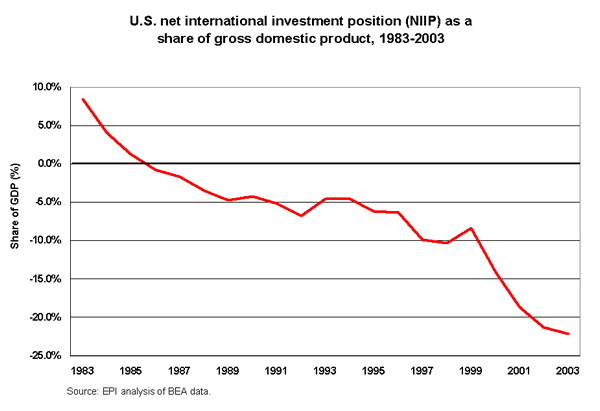See Snapshots Archive.
Snapshot for June 30, 2004
Rapid increase in foreign liabilities threatens U.S. recovery
Mounting trade deficits have caused the United States to incur rapidly growing obligations to foreign investors. To finance the nation’s trade deficits, the United States must sell off more of its assets to foreign investors or reduce the stock of U.S. assets held overseas. The net effect is a rapidly deteriorating net international investment position (NIIP). The U.S. NIIP, measured as a share of total gross domestic product (GDP), deteriorated sharply from 1982 through 2003 as the asset sales necessary to finance trade deficits transformed the United States from the world’s strongest international asset position to the world’s largest liability position.
As recently as 1985, the United States still had more assets than liabilities abroad. Since then, the U.S. NIIP has deteriorated so substantially that the value of foreign holdings here now exceeds that of U.S. holdings abroad by 22.1% of GDP, about $2.4 trillion in 2003.1 U.S. NIIP as a share of GDP has followed a declining path since the early 1980s, as shown in the figure below. In addition, most projections of international economic activity show that the U.S. trade deficits and negative asset position will continue to grow rapidly in coming years unless the United States takes steps to slow their growth or foreign investors limit the flows of new capital to the United States.

Financial crises afflicting developing and industrialized countries in the 1980s and 1990s demonstrated that large trade deficits can have devastating economic consequences. While some economists argue that the United States is a special case, immune to this kind of crisis, recent research contradicts that viewpoint. A study by the U.S. Federal Reserve identified 25 periods of rapid improvement in the current account balance (the broadest measure of a country’s trade deficit) in industrial countries between 1980 and 1997. The median current account deficit when adjustment began in these countries was 4.9%, and the median reduction in this deficit after three years was 4.1%.2 The U.S. current account deficit reached 5.1% of GDP—an annual rate of about $580 billion—in the first quarter of 2004. A rapid, unplanned adjustment could cause interest rates to spike and stock prices and the value of the U.S. dollar to fall. These changes would threaten the current economic recovery, still in the very early stages of serious job growth.
When countries develop large trade deficits and rising net liabilities, private lenders ultimately become less willing to finance those deficits. As a result, foreign governments provided $249 billion, or 46.8%, of all net U.S. capital inflows in 2003. Most of that capital came from China, Japan, and other Asian countries, which sought to reduce pressures on their currencies to appreciate against the dollar. The longer the dollar remains far too high, the greater the risk of a sudden break in the dollar, which would lead to financial disruption and a “hard landing” that would quickly reduce U.S. current account deficits at huge costs to the economy. The best way to avoid this threat is to bring about a large (i.e., 40%), sustained reduction in the real, trade-weighted value of the dollar. Such a reduction would lower import growth, increase exports, and reduce the trade deficit. By intervening in U.S. currency markets to prevent dollar and trade adjustment, Asian governments are putting the United States and global recoveries at risk.
For additional analysis of the effect of foreign government intervention on the value of the dollar, see the Snapshot titled Foreign government intervention keeps the value of the dollar artificially high, updated with new data on June 30, 2004.
1. Note that annual changes in the NIIP to GDP ratio should not be emphasized because they are heavily influenced by changes in currency values. This ratio is measured in dollars. In 2003 net financial flows reduced the NIIP by $546 billion. However, the effects of these flows were offset by exchange rate gains of $255 billion due to the rising value of many foreign currencies against the dollar. Similarly, the NIIP was effectively exaggerated in the late 1990s by the decline in those currencies.
2. Freund, Caroline. 2000. Current Account Adjustment in Industrialized Countries. Federal Reserve Board of Governors: (December). http://www.federalreserve.gov/pubs/ifdp/2000/692/default.htm
Source: EPI calculations based on data from the Bureau of Economic Analysis, http://www.bea.gov/.
This Snapshot was written by EPI economist Robert E. Scott, with research assistance by Adam Hersh.
